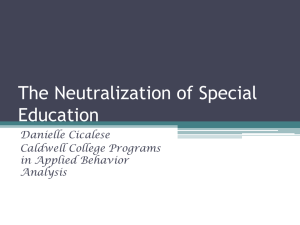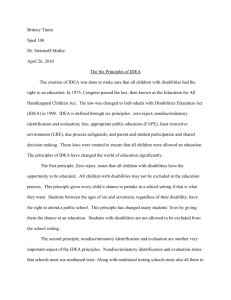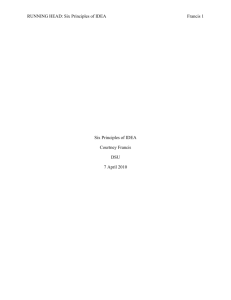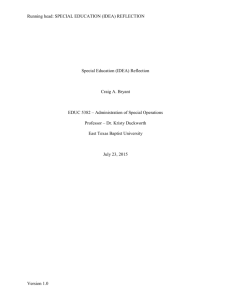File
advertisement
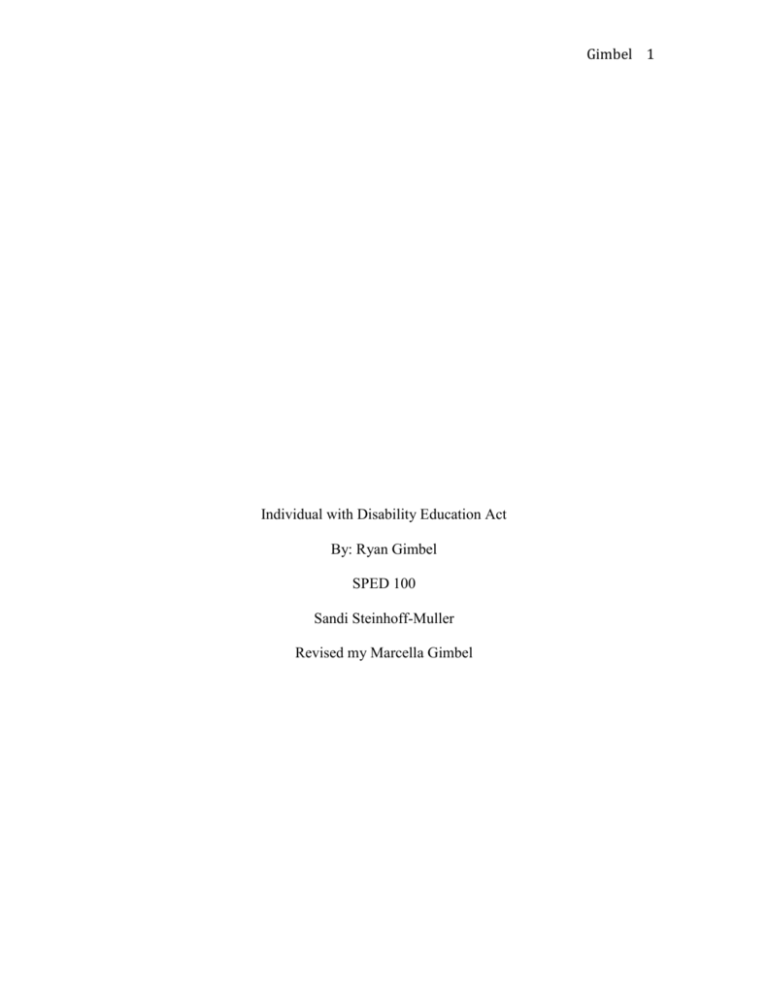
Gimbel 1 Individual with Disability Education Act By: Ryan Gimbel SPED 100 Sandi Steinhoff-Muller Revised my Marcella Gimbel Gimbel 2 Abstract The following contents of essay will be discussing elements of Individuals with Disabilities Education Act. It will cover the six principles Zero Reject, Nondiscriminatory Evaluation, Free Appropriate Public Education, Least Restrictive Environment, Procedural Safeguards, and Parent Participation and Shared Decision Making. Also covering other points that tie into IDEA. When IDEA is used properly it gives fraught students the keys to becoming successful. Gimbel 3 In 1975 Congress passed Public Law 94-142 originally called Education for All Handicapped Children Act (Heward, 2013). The goal of this law was to improve students with disabilities education. PL 94-142 was amended 5 times, the 1990 amend changed the name of the law to Individuals with Disabilities Act (IDEA), which is most often referred too (Heward, 2013). The most recent modification was in 2004, in which the name was changed to The Individuals with Disabilities Education Improvement (Heward, 2013). IDEA had a tremendous effect on the school system, both faculty and students were affected. IDEA law proposes that all students with disabilities be treated like full citizens with same rights and privileges that all non-disabled students experience. The purpose of IDEA is to ensure that all children with disabilities have available to them a free appropriate public education that emphasizes special education and related services designed to meet their unique needs and prepare them for further education, employment, and independent living (Heward, 2013). IDEA is broken up into six major principles: zero reject, nondiscriminatory evaluation, free appropriate public education (FAPE), least restrictive environment (LRE), procedural safeguards, parents participation and shared decision making.(Heward, 2013). Zero Reject states that schools must educate all children with disabilities, no child with disabilities may be excluded from a free public education, regardless of the nature or severity of the disability (Heward, 2013). The requirement to provide special education to all students with disabilities is absolute between the ages six and seventeen. Each states education agency is responsible for locating, identifying, and evaluating all children, Gimbel 4 from birth to age twenty one (Heward, 2013). This requirement of IDEA is called the child find system. Nondiscriminatory evaluation declares that schools must use nonbiased, multifactored methods of evaluation to determine whether a child has a disability and if so, whether the child needs specially designed instruction to benefit from education (Heward, 2013). Testing and evaluation must not discriminate on the basis of race, culture, or native languages (Heward, 2013). Test must also be presented in the student’s native language. Test scores may also not be based on one test score. These provisions of IDEA are known as protection in evaluation procedures. Free appropriate public education (FAPE) states all children with disabilities, regardless of the type or severity of their disability, shall receive a free appropriate public education (Heward, 2013). The education must be provided at public expense, meaning without expense to their parents (Heward, 2013). When students have unique needs or circumstances an individualized education program (IEP) is to be formed. The IEP specifies the child’s present levels of performance, identifies measurable annual goals, and describes the specific special education and related services that will be provided to help the child attain those goals and benefit from education (Heward, 2013). For example a student who has a wheelchair may require a handicapped accessible van for use to and from school: it is the schools responsibility to provide proper accommodations at no expense to the parents. A student with an orthopedic impairment may need physical therapy to maintain sufficient strength and flexibility in her/his arms and legs. IDEA requires that schools provide any related services and assistive technology that a child with a disability may need to access and benefit from special education (Heward, 2013) Gimbel 5 Least Restrictive Environment (LRE) requires schools to educate students with disabilities with children without disabilities to the maximum extent appropriate and that students with disabilities be removed to separate classes or schools only when the nature or severity of their disabilities is such that they cannot receive an appropriate education in a general education classroom with supplementary aids and services (Heward, 2013). If a student is moved into a location that is not the current classroom this must be stated on the IEP form with justification. To ensure that each student with disabilities is educated in the LRE appropriate for his/her needs, school district must provide a continuum of alternative placements and service alternatives, for example: resource room, special classroom and special schools (Heward, 2013) Procedural safeguards states that schools must follow an extensive set of procedures to safeguard and protect the rights and interests of children with disabilities and their parents (Heward, 2013). Parental consent must be gained for adequate assessment and placement. Schools must maintain confidentiality of all records pertaining to a child with disabilities and make those records available to the parents (Heward, 2013). When parents of a child with disabilities disagree with the results of an evaluation performed by the school, they can obtain an independent evaluation at pubic expense (Heward, 2013). When the school and parents disagree on the identification, evaluation, placement, or provision of a FAPE and related services for the child, the parents may request a due process hearing (Heward, 2013). Parent participation and shared decisions making claims that schools must collaborate with parents and students with disabilities in the planning and implementation Gimbel 6 of special education and related services (Heward, 2013). Parent’s wishes and concerns must be considered when determining IEP goals (Heward, 2013). Granted the six principles are the foundations in which IDEA is built upon, there are however additions provisions of IDEA. Some of the provisions for example include special education for preschoolers, assistive technology, and scientifically based instruction. States are serving at most 70% of preschool children with disabilities and that early interventions services for infants and toddlers with disabilities from birth through age two were scarce of nonexistent in many states, Congress included provisions in the education of the Handicapped Act Amendments in 1986 (Pl 99-457) to expand services for these segments of the population (Heward, 2013). This requires all states to serve preschool children with disabilities ages three-five. The law defines assistive technology as “any item, piece of equipment, or product system, whether acquired commercially off the shelf, modified, or customized that is used to increase, maintain, or improve functional capabilities of a child with disability” (Heward, 2013). This technology can include alternative and augmentative communication devices, low-vision aids, positioning and mobility devices, and adaptive toys and games (Heward, 2013). As stated in FAPE the school must provide accommodations for those needs, like wheel chair accessible vans, wheelchair ramps, or bathroom accommodations. The basic idea of universal design for learning (UDL ) is that new curricular materials and learning technologies should be designed from the beginning to be flexible enough to accommodate the learning styles of a wide range of individuals (Heward, Gimbel 7 2013). Many different strategies to help students learn must be attempted to prove optimal success. When congress passed IDEA in 1975 it promised to provide federal funds for 40% of the excess cost of educating children with disabilities (Heward, 2013). But congress has never actually appropriated more than 18% of the national average (Heward, 2013). IDEA has had a positive affect in school. If it weren’t for the passing of IDEA in 1975 my cousin Derek whom suffers from Down Syndrome would not be allowed a free public education. By attending public school he has been able to fully experience a regular classroom, while still being able to attain one on one interaction in the special education classroom. By exposing Derek to students in a regular classroom setting he has learned qualities such as friendship, discipline, and patience. IDEA has improved the overall education of students with disabilities. Without this law students with disabilities would not be treated equally in a classroom setting. This law gives students with disabilities a chance at obtaining a proper education. With this law instilled students everywhere will have the opportunity of gaining a free appropriate education in an unbiased least restrictive environment. Work Cited Gimbel 8 Heward, W. L. (2013). Exceptional children (10th ed., International ed.). Upper Saddle River: Pearson.
